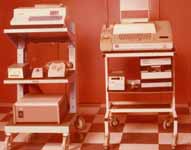Supervisory frames
Unumbered format frames
SARM set asynchronous response mode
SABM set asynchronous balanced mode
UA - Unnumbered acknowledgment response
DM - Disconnected mode Response
Frame Types
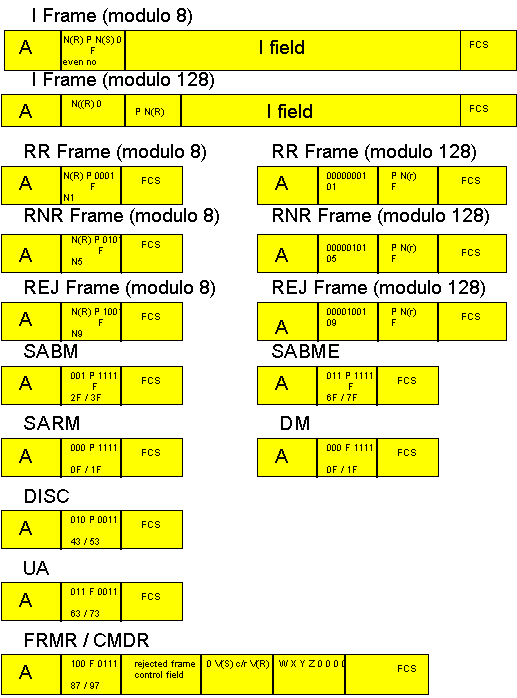
I Information frame
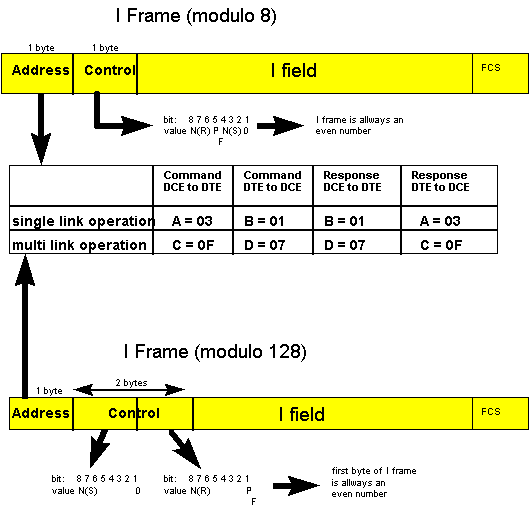
I frames are numbered. The N(S) count provides for numbering the frame being
sent and the N(r) provides acknowledgement for the I frames received. When duplex
information exchange
is in continual process, each station reports its current N(s) and/or N(r) counts
in each I or S frame exchanged.
Supervisory frames
RR - Receive Ready
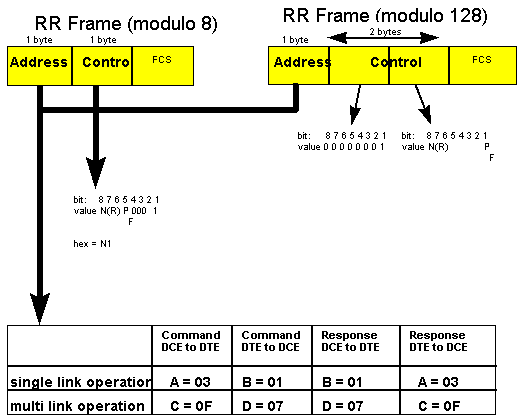
The RR frame confirms numbered I frames upto N(R)-1 and indicates that the
originating station is ready to receive.
An RR can be sent as a response to an I frame.
An RR can also be sent as a command to 'poll' the other end of the link.
RR as a response
----------------
------ I -------->
<----- RR --------
Command RR
----------
------ RR P ------>
<----- RR P -------
RNR - Receive Not Ready
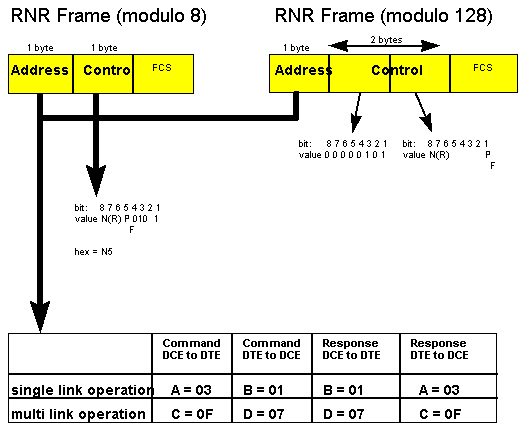
The RNR frame confirms numbered I frames upto N(R)-1 and it also indicates
a temporarily busy condition due to buffering or other internal constraints.
<----- I -------
------ RNR ---->
busy on
this end should not send any more I frames
------ RR ----->
busy off
this end free to send I frames again
due to a bug in Public Network, if busy is put on with RNR with P-bit=0 it
cannot be put off again with P-bit=1.
slide REJ
REJ - Reject
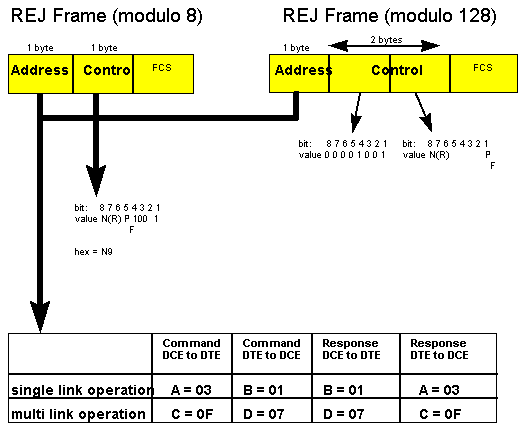
This command/response may be transmitted to request transmission or retransmission
of numbered information frames. REJ confirms frames through N(R)-1 and requests
the retransmission of numbered information frames starting at the N(R) contained
in the REJ frame.
| <--- I N(s)=5 --- | |
| I frame 6 is lost perhaps due to noise | |
| <--- I N(s)=7 --- | |
| ---- REJ N(R)=6 --> | confirms frames upto 5 requests retransmission of 6 |
| <--- I N(s)=6 |
Unumbered format frames
SARM set asynchronous response mode
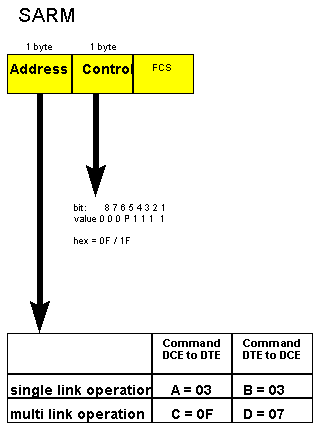
asynchronous response mode (ARM) was used in the early days of X.25 now being
phased out.
Sets asynchronous response mode - brings the link up in one direction. So
to bring the link up fully requires an exchange in both directions as follows:
------ SARM ------>
<----- UA ---------
<----- SARM -------
------ UA -------->
SABM set asynchronous balanced mode
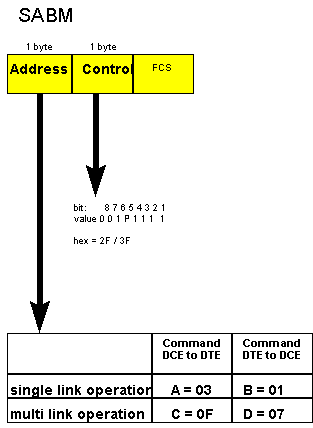
the SABM can be sent by either end of the link to place the link in asynchronous
balanced mode. If the link is already in ABM a SABM-UA exchange can be used
to reset the sequence numbers and to clear any RNR busy condition any previously
transmitted I frames that are unacknowledged remain unacknowledged.
assume link is down
----- SABM ------>
<---- UA ---------
link is now up
In theory either end could bring the link up, in practice Public Network always leaves
it to the DTE to bring the link up, this is because Public Network does not know if the
DTE wants to use ABM or ARM.
SABME set asynchronous balanced mode extended
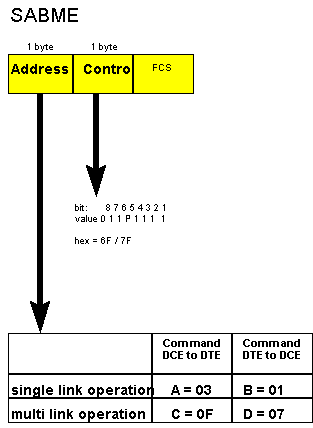
as for SABM but starts modulo 128 operation - not used on Public Network.
DISC - Disconnect command
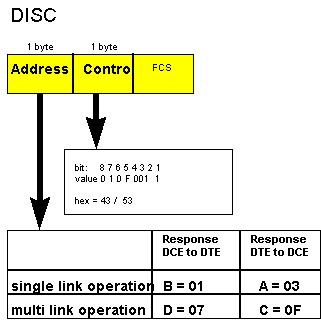
The Disc command can be used by any end of the link to terminate the mode
previously set and to put the link into the down state.
assume link up
<--- DISC ---------
---- UA ---------->
link is now down
In Public Network the DISC frame is also used by the network
to poll the DTE when the link is in the down state.
| DTE | DCE | |
| <--- DISC ----- | ||
| <--- DISC P --- | ||
| <--- DISC P --- | ||
| <--- DISC P --- | ||
| ---- UA P ----> | the network will continue polling until the DTE responds with a UA the network will then wait for the DTE to bring the link up with a SARM or a SABM |
UA - Unnumbered acknowledgment response
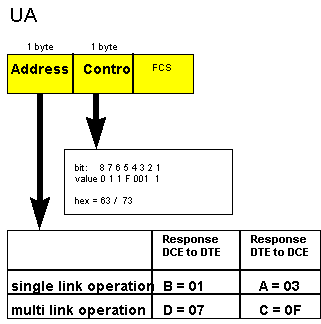
The UA unnumbered response is used by the DTE to acknowledge the receipt and
acceptance of the SABM/SABME and DISC unnumbered commands. Received SABM/SABME
and DISC unnumbered commands are not actioned until the UA response is transmitted.
DM - Disconnected mode Response
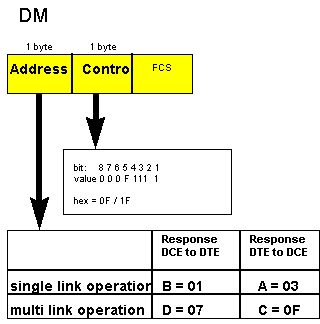
The DM response is used to report a status where the sender is logically disconnected
from the link, and is in the disconnected phase. The DM response may be sent
in this phase to request a set mode command, or, if sent in response to the
reception of a set mode command, to inform the remote end that the sender is
still in the disconnected phase and cannot action the set mode command.
| Command With P bit set | DM |
| Command without P bit set | ignore |
| SABM | UA or DM |
In Public Network if DM sent in response to polling discs, polling is stopped for T3=T1
* N2
FRMR - frame reject response
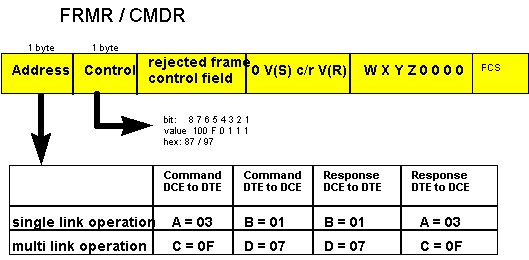
This response is transmitted when it receives an invalid frame other than bad FCS which are ignored or N(S) errors - REJ
A received frame may be invalid for several reasons:
- its Control field is not implemented at the receiving station. This category includes unassigned commands.
- the information field is too long to fit the receiving station buffers
- The Control field in the received frame does not allow an I field to be received with the frame.
- The N(r) that was received from the primary station is invalid.
